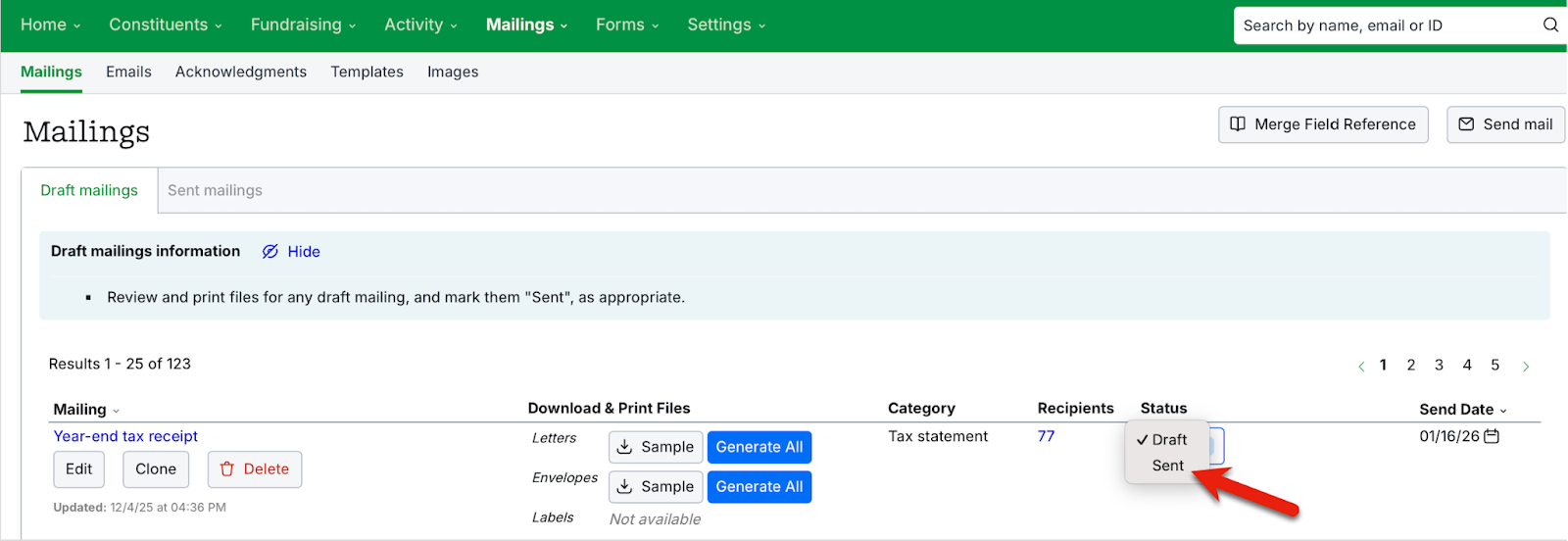Generate and send a customized year-end tax statement/receipt by mail
In this article:
- Introduction
- Write your letter
- Use a total giving Smart Field to generate a list of gifts in your mailing, if needed
- Build a search (e.g., for last year's donors)
- Create the mailing
- Upload your letter file, or
- Write your simple LGL letter
- Label/envelope preferences and other settings
- Review, download, and print your mailing
- Mark the mailing "Sent"
Introduction
Sending year-end tax receipts and/or annual statements is a great way to give your donors the information they need to file their taxes, and simultaneously thank them again for their support. It's also an opportunity to let them know how they have helped your mission, which is critical for donor retention and just makes good sense.
You can create custom year-end tax receipts, or annual statements, in LGL and mail them to your donors via a stepped process that will allow you to:
- Add or remove individual recipients from your mailing
- Prepare your letter text, including adding LGL merge fields
- Review your work
- Define other mailing settings, including name and type
- Preview the individual letters that will go out and, when ready, print them for sending
This article shows you this process from beginning to end, in the sections that follow.
Is there a simpler way?
Yes, there is a simpler way to prepare a year-end tax statement (or annual statement) for every donor. Please see Quickly generate a simple annual gift statement in your account for more information. Note, however, that this method doesn’t allow customizations in the recipients list.
If you want to proceed with creating a custom year-end tax statement mailing, please follow the instructions below.
Write your letter
If you will be mailing physical letters as year-end tax statements, you can either create the letter in Microsoft Word, or you can create a simple LGL letter.
NOTE: You will pull a list of gifts into your mailing using a gift summary merge field that references the previous year. The merge field will follow the [[gifts.YYYY.list]] format.
Here is an example of how your letter might look:

The key part of the letter is the merge tag of [[gifts.YYYY.list]], which pulls a full itemization of the gifts from the giving year—with dates, deductible amounts, and notes—into a list in the merged letter, where "YYYY" equals the year of the gift. In the example above, the year is 2022.
NOTES ABOUT USING MERGE FIELDS THAT RESULT IN A LIST
- The [[gifts.YYYY.list]] merge field will include in-kind gifts but will not show any amount (it's a best practice for nonprofits not to provide a value, or deductible amount, for in-kind gifts). For in-kind gifts the table will, however, show the gift note for the in-kind gift, if there is one present in the record.
- Any merge field resulting in a list must be placed on its own line in your letter content, without any additional text or spacing around it. (You can see this in the preceding screenshot of a sample tax statement letter, in the case of the merge field [[gifts.YYYY.list]].) Even one extra space on either side of the merge field in your letter content can cause an error in your mailing when the letters are merged.
Once you have the letter completed, save it to a folder location on your computer where you’ll easily be able to navigate to it, because you’ll soon upload it into the mailing you will create for your year-end tax statements.
Example letter in your account
In your LGL account, you can find an example template and letter all ready to go. Navigate to Mailings > Letter Templates, and then the Example tab:

NOTE: Use of the example letter template requires that your computer be running MS Word 2007 or later.
You'll want to customize the content in the Word document as well as rename it (using the applicable year is always a good choice). You can download the file by clicking on the file name and saving it with the new name. You can then upload this version later when you're creating a mailing. (You can create a template for your mailing first if you want to reuse it in the future, or you can simply upload the Word doc you created directly into the mailing itself.)
Use a total giving Smart Field to generate a list of gifts in your mailing, if needed
If you want to use a total giving Smart Field in your letter, your Merge Field Reference will provide a merge field you can use that will display a list of those gifts.
First create your total giving Smart Field. Then go to your Merge Field Reference and scroll down to the "Smart Fields" section. The merge field will be available there for you to copy and paste into your letter content.

IMPORTANT NOTE: Smart Field lists require that you include at least one additional column. For example, you could add a column for deductible amount, so your merge field looks like this:
[[smart_field.total_giving_last_year.gift_list: deductible_amount]]
Make sure your Smart Field is saved in your letter content before you upload your Word document into the mailing.
Build a search (e.g., for last year's donors)
Your next step is to build a search that contains the constituents you want to send the letter to.
Begin by searching for “last year’s donors” in the Advanced Search area within the Constituents tab.* This search will pull in anyone who gave a gift "last year" with a gift type of “Gift” or “In Kind”.

* We are using the example of last year’s donors as the subset of your constituents who would typically receive a year-end tax statement, but you can search for whoever you want to send it to. If those you are targeting don’t specifically meet the available search criteria, you can create a list that includes them and pull that list into your search.
Create the mailing
If the search results look right, click on the Send mail button to the upper right:
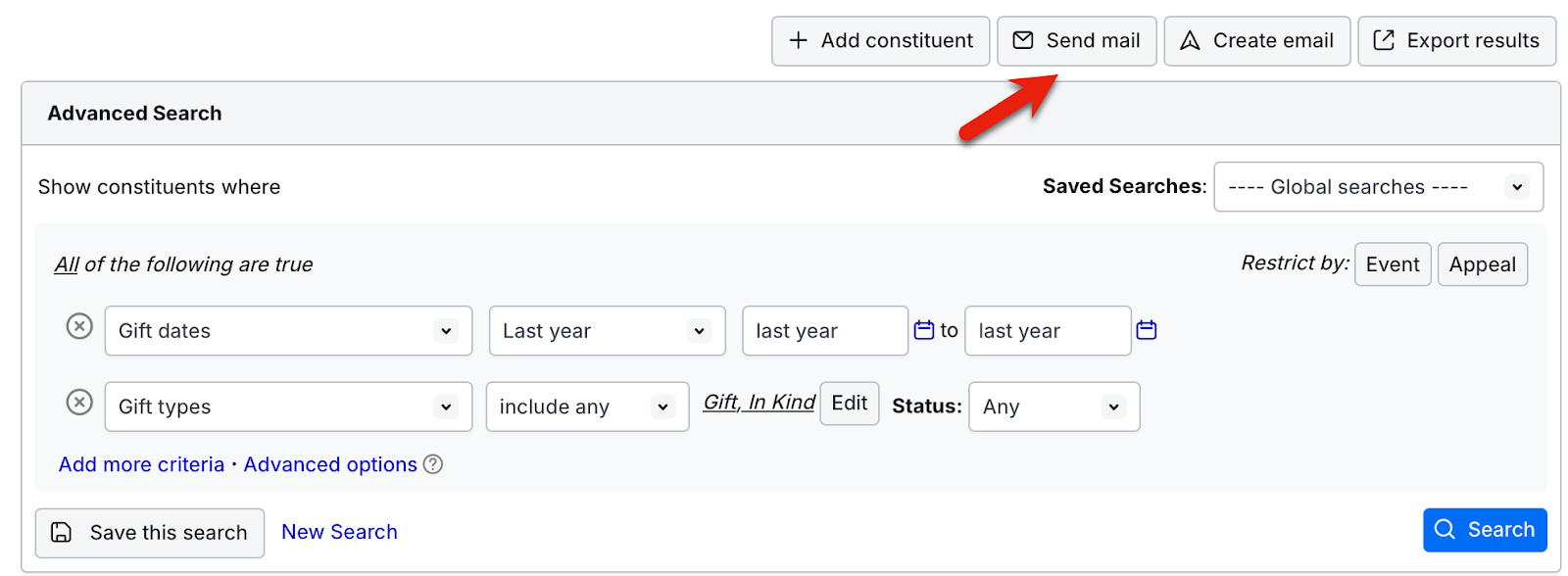
You’ll be taken to the mailing builder, where you can set up the mailing by proceeding through the steps:

Upload your Word letter file
To upload your Microsoft Word letter file into your mailing, make sure you're looking at step 2, Letters, labels & envelopes. Then click on the Upload new file button and browse for your Word file. Please be sure to leave the "Template" selection set to "Custom MS Word" if you are uploading a Word document as your letter template.
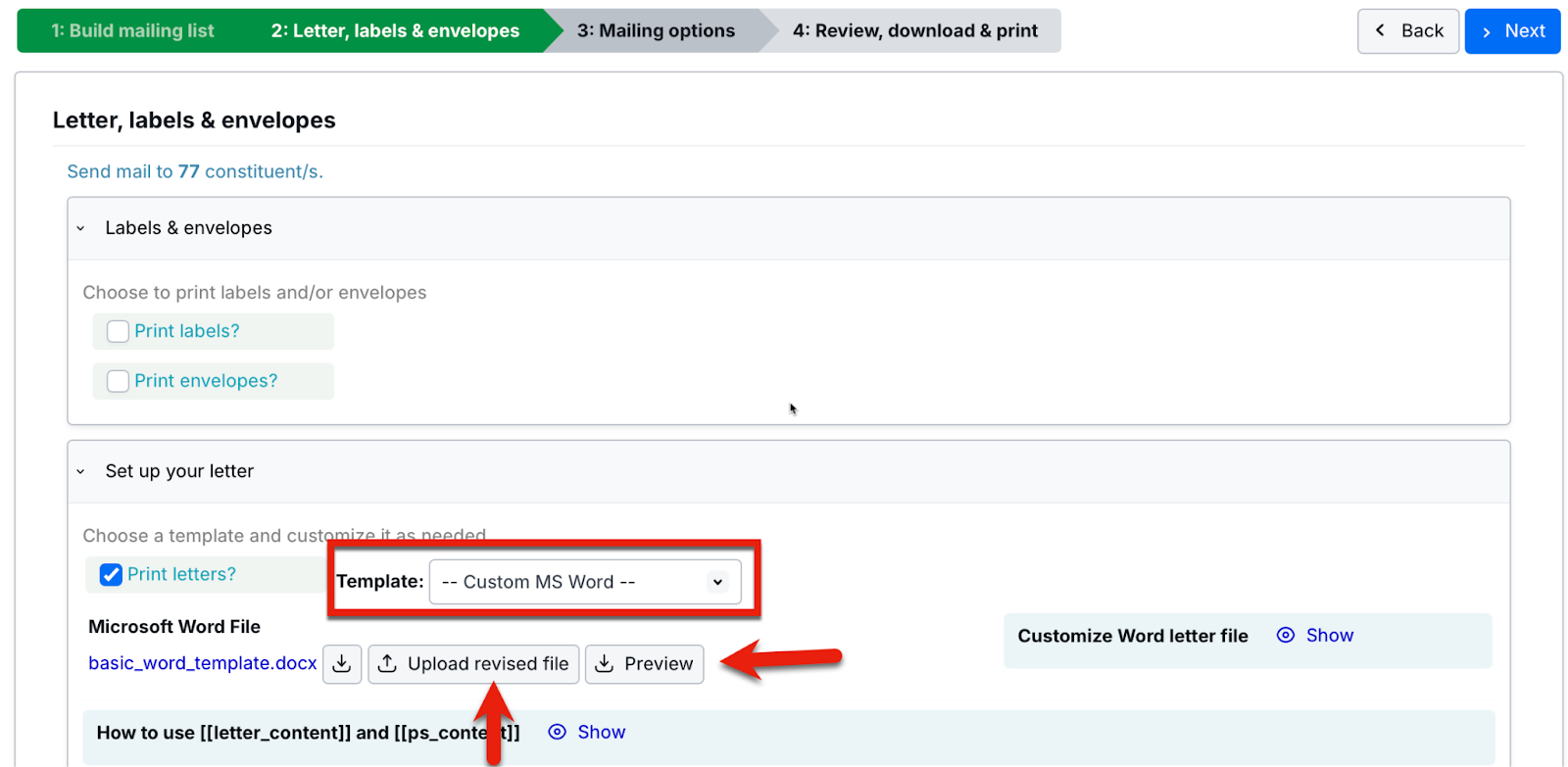
When you are using the Letter Content and P.S. Content panes to draft your letter, please leave the Microsoft Word file named basic_word_template attached within your mailing (it is there by default), because this document is the mechanism by which the contents of your Letter Content and P.S. Content windows are merged into your letter (the exception to this is if you have added the [[letter_content]] and [[ps_content]] fields directly to your uploaded template):

Preview your letter
To see how your letter will look, click the Preview button, which will show you a preview of the first 5 letters in your mailing. If anything is amiss, you can revise the letter and then click the Preview button again to check the results of your revision. Lather, rinse, and repeat until the preview looks the way you want.
Write your simple LGL letter
If you are using a simple LGL letter, the data from your LGL database will be merged into the content in the Letter Content pane in the mailing builder to generate your letters. You can either use the example merge fields and content provided, or you can type your own. To add a merge field from the list provided to the right of the Letter Content pane, click on the name of the merge field:
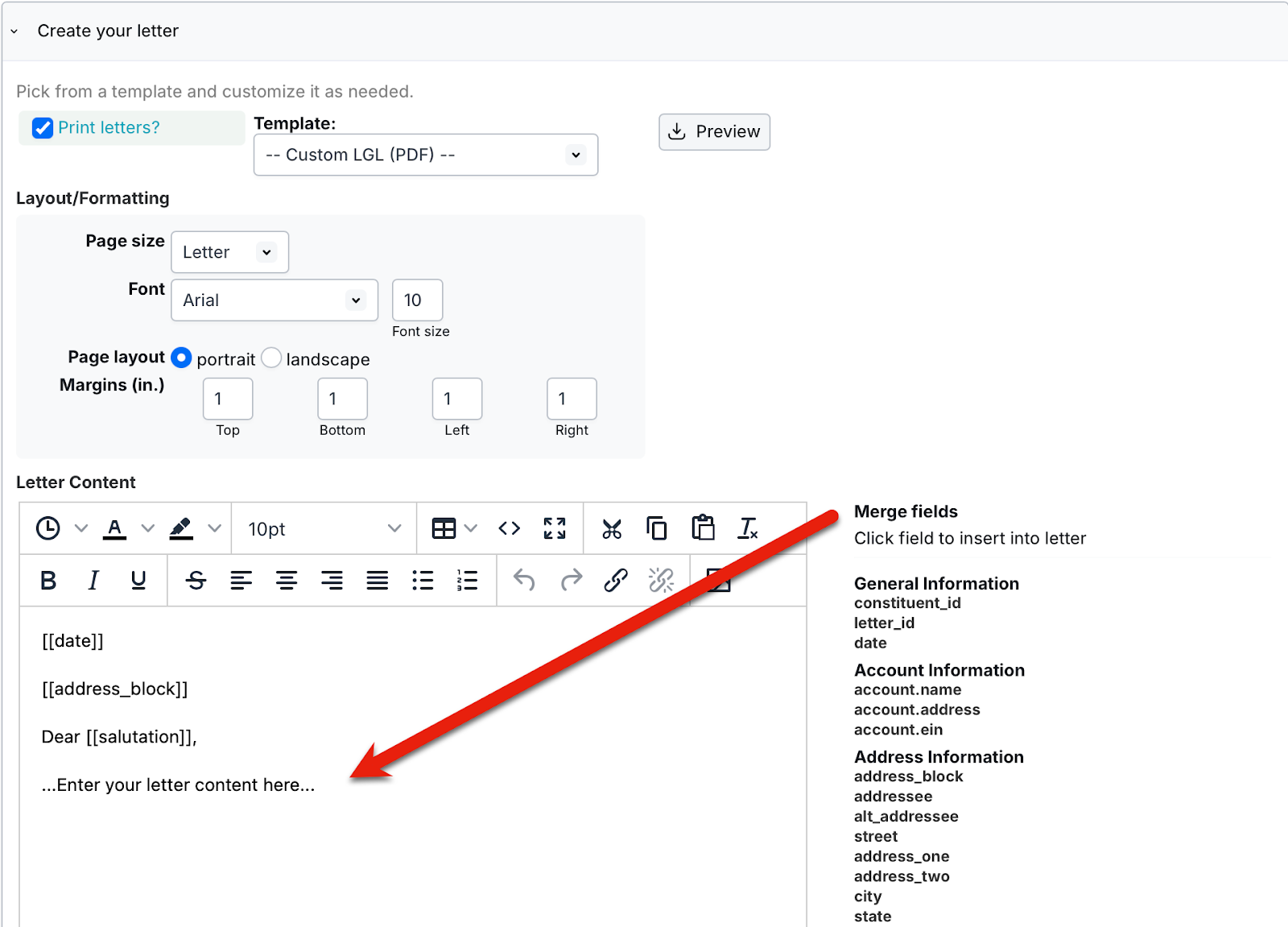
Preview your letter
To see how your letter will look, click the Preview button. This will show you a preview of the first 5 letters in your mailing. If anything is amiss, you can revise the letter and then click the Preview button again. Lather, rinse, and repeat until it looks the way you want.
Label/envelope preferences and other settings
You can configure your preferences for labels and envelopes as shown below, in step 2:

You will need to choose which template to use for either labels or envelopes. You can preview and customize from here as well:

Click Next to name your mailing and configure the settings for your mailing.
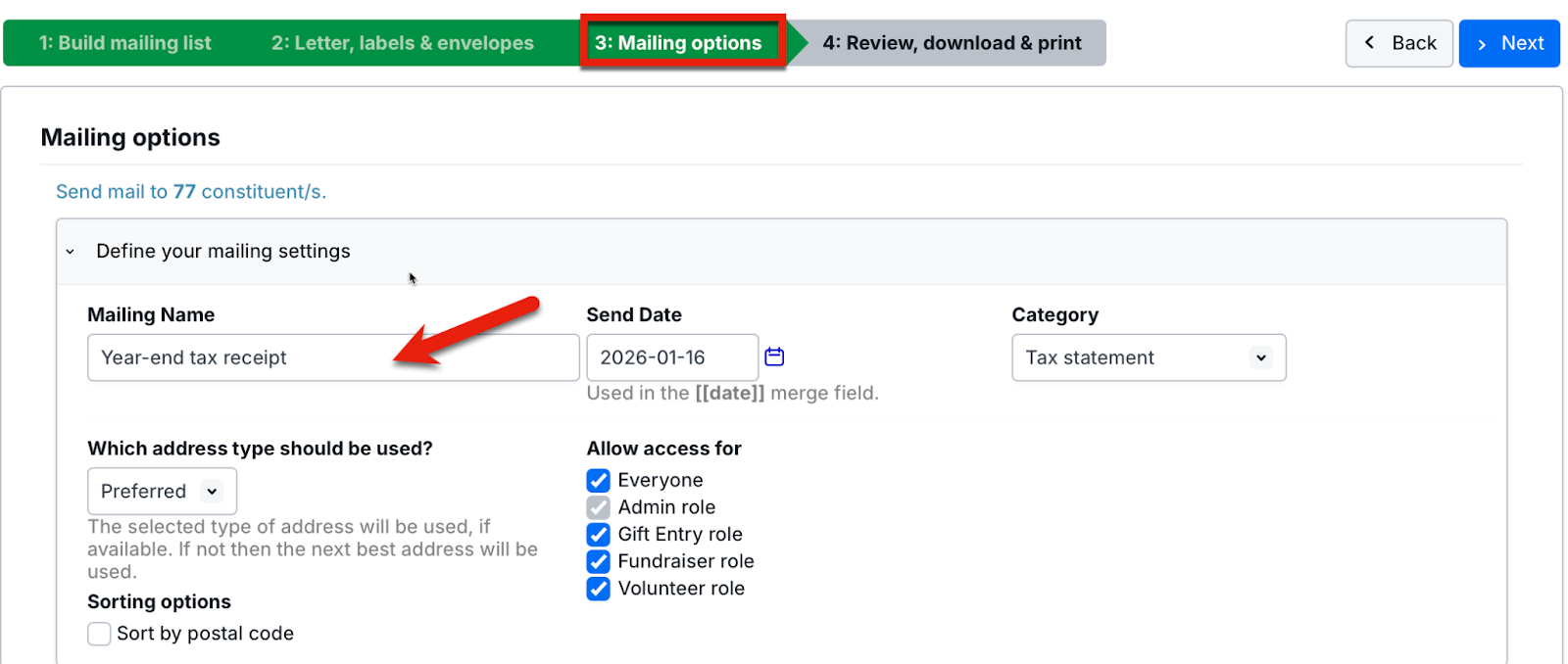
Review, download, and print your mailing
This next step gives you the opportunity to review the details of your mailing. If any time has passed between the creation of the mailing and sending it, you can click the Refresh button to make sure all constituents are brought into the recipients list. This is in case there have been updates in your data and more constituents should receive the year-end tax letter.

Make sure you have the correct templates (if you’re using templates for your letter, labels, or envelopes) or Word letters attached, and confirm that the address block is correct. You can also see if any of the constituents in your search are being excluded (due to communication tags in their constituent records or invalid mailing addresses):
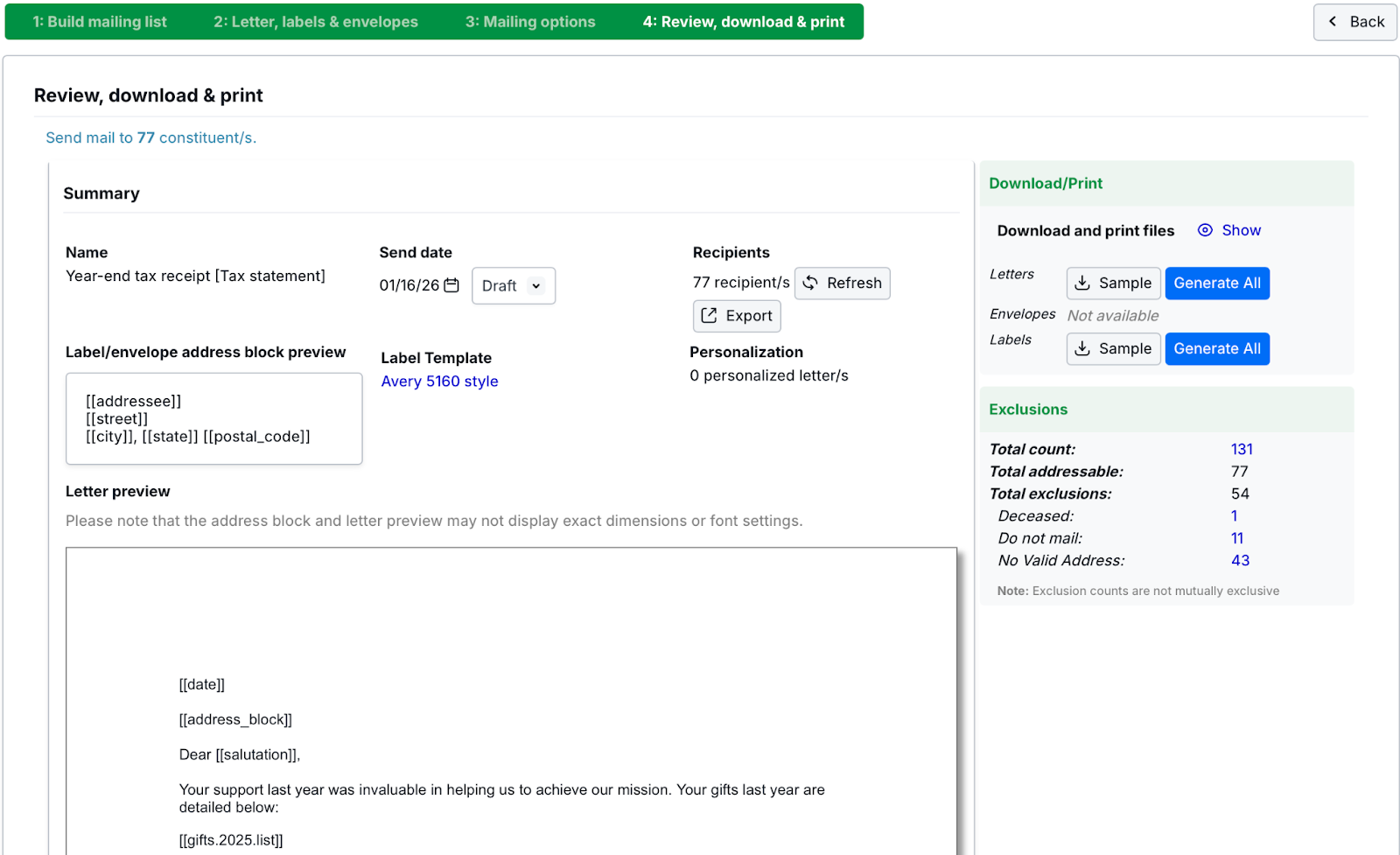
From this page, you can download your letters and your envelopes or templates and print them by clicking the applicable Download All buttons:
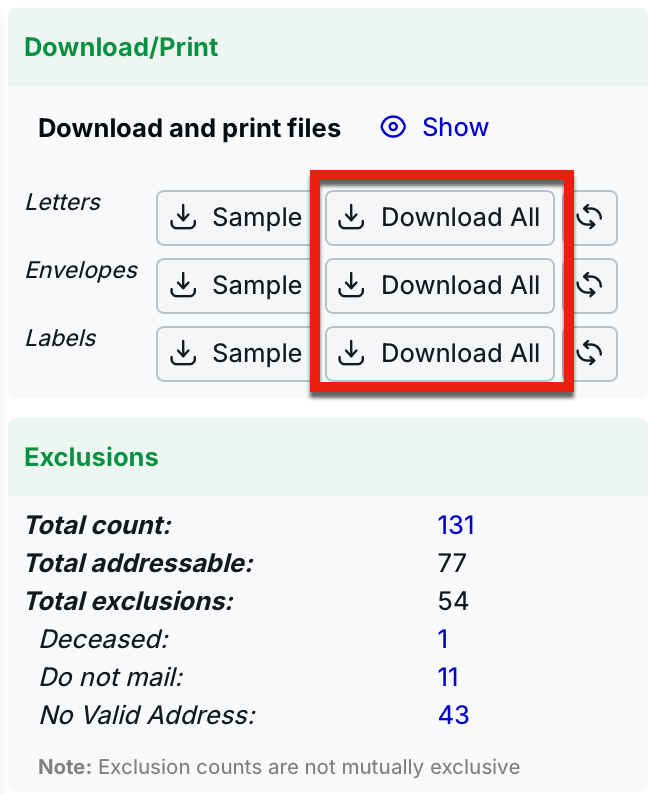
NOTE: If your mailing has more than 50 recipients, a Generate All button will appear in place of the Download All button. Click the Generate All button and then the Download All button in this case. This will download the files to your computer, where you can open them in Word and print them, just like you would print any other Word document.
The final result should look something like this:

You will want to make sure you download all the files you need for the mailing (letters, labels, and/or envelopes).
Mark the mailing "Sent"
Once your letters are ready to go out the door, you can mark the mailing as "Sent" to archive it and ensure that the mailing is noted in each constituent’s record who received it:
